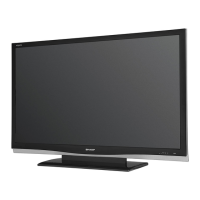Do you have a question about the Sharp AQUOS LC-65N7000U and is the answer not in the manual?
Connect an antenna, cable box, or satellite receiver using coaxial cable.
Connect AV devices using composite cables (red, white, yellow) for audio and video.
Connect AV devices using component cables (Y, PB, PR) for higher quality video.
Connect devices via HDMI for high-definition audio and video signals.
Connect MHL-enabled devices like phones to mirror screen content.
Connect headphones to the TV's audio out port for private listening.
Connect external speakers or audio systems for enhanced sound output.
Connect a sound bar via HDMI/ARC for audio output and remote control.
Connect USB devices like drives for media playback and file access.
Set up a wireless network connection using the built-in adapter and compatible router.
Connect the TV to a local area network using an Ethernet cable for internet access.
Identify and understand the functions of each button on the TV remote control.
Information on the operating distance and angle of the remote control.
Insert batteries and prepare the remote control for first-time use.
Program universal remotes from cable/satellite providers to control the SHARP TV.
Instructions on how to power the TV on and off using the remote control.
Guide to switching between different input sources connected to the TV.
Accessing and viewing live broadcast television channels.
Information on performing channel scans and tuning.
Tips for starting Live TV and viewing channel information after setup.
Create a list of preferred channels for quick access.
View channels previously added to your Favorites List.
Navigate the main settings menu to access various TV configurations.
Adjust picture settings like mode, brightness, contrast, color, and aspect ratio.
Configure audio settings such as sound mode, enhancements, volume, and equalizer.
Manage TV channels, including tuner mode, auto scan, channel skip, and favorites.
Set up wired or wireless network connections for internet access and smart features.
Configure system settings like location, time, language, sleep timer, and parental controls.
Adjust analog and digital closed captioning settings for accessibility.
Control CEC-enabled devices connected via HDMI for seamless interaction.
View system information, legal disclaimers, and firmware update status.
Block content based on ratings and create a PIN for access control.
Connect an antenna, cable box, or satellite receiver using coaxial cable.
Connect AV devices using composite cables (red, white, yellow) for audio and video.
Connect AV devices using component cables (Y, PB, PR) for higher quality video.
Connect devices via HDMI for high-definition audio and video signals.
Connect MHL-enabled devices like phones to mirror screen content.
Connect headphones to the TV's audio out port for private listening.
Connect external speakers or audio systems for enhanced sound output.
Connect a sound bar via HDMI/ARC for audio output and remote control.
Connect USB devices like drives for media playback and file access.
Set up a wireless network connection using the built-in adapter and compatible router.
Connect the TV to a local area network using an Ethernet cable for internet access.
Identify and understand the functions of each button on the TV remote control.
Information on the operating distance and angle of the remote control.
Insert batteries and prepare the remote control for first-time use.
Program universal remotes from cable/satellite providers to control the SHARP TV.
Instructions on how to power the TV on and off using the remote control.
Guide to switching between different input sources connected to the TV.
Accessing and viewing live broadcast television channels.
Information on performing channel scans and tuning.
Tips for starting Live TV and viewing channel information after setup.
Create a list of preferred channels for quick access.
View channels previously added to your Favorites List.
Navigate the main settings menu to access various TV configurations.
Adjust picture settings like mode, brightness, contrast, color, and aspect ratio.
Configure audio settings such as sound mode, enhancements, volume, and equalizer.
Manage TV channels, including tuner mode, auto scan, channel skip, and favorites.
Set up wired or wireless network connections for internet access and smart features.
Configure system settings like location, time, language, sleep timer, and parental controls.
Adjust analog and digital closed captioning settings for accessibility.
Control CEC-enabled devices connected via HDMI for seamless interaction.
View system information, legal disclaimers, and firmware update status.
Block content based on ratings and create a PIN for access control.











